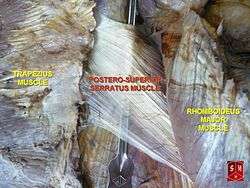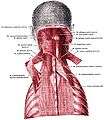Serratus posterior superior muscle
| Serratus posterior superior muscle | |
|---|---|
 Thin film-like object, at center, is serratus posterior superior muscle. | |
| Details | |
| Origin | Nuchal ligament (or ligamentum nuchae) and the spinous processes of the vertebrae C7 through T3 |
| Insertion | The upper borders of the 2nd through 5th ribs |
| Artery | Intercostal arteries |
| Nerve | 2nd through 5th intercostal nerves |
| Actions | [1] |
| Identifiers | |
| Latin | Musculus serratus posterior superior |
| TA | A04.3.01.011 |
| FMA | 13401 |
The serratus posterior superior is a thin, quadrilateral muscle, situated at the upper and back part of the thorax, deep to the rhomboid muscles.
It arises by a thin and broad aponeurosis from the lower part of the ligamentum nuchae, from the spinous processes of the seventh cervical and upper two or three thoracic vertebrae and from the supraspinal ligament.
Inclining downward and lateralward it becomes muscular, and is inserted, by four fleshy digitations, into the upper borders of the second, third, fourth, and fifth ribs, a little beyond their angles.
The function of serratus posterior superior is to elevate second to fifth ribs, which aids deep inspiration.
Additional images
 Position of serratus posterior superior muscle (shown in red).
Position of serratus posterior superior muscle (shown in red). Serratus posterior superior muscles are labeled at center left and center right.
Serratus posterior superior muscles are labeled at center left and center right.
See also
References
- ↑ According to Moore et al (Moore Clinically Oriented Anatomy 7th Edition Chapter 1: Thorax, page 86) and Vilensky et al (Clin Anat. 2001 Jul;14(4):237-41. Serratus posterior muscles: anatomy, clinical relevance, and function. Vilensky JA, Baltes M, Weikel L, Fortin JD, Fourie LJ : The serratus posterior superior and inferior muscles are generally considered clinically insignificant muscles that, based on attachments, probably function in respiration. Interestingly, however, there is no evidence supporting a respiratory role for these muscles. In fact, some electromyographic data refute a respiratory function for these muscles. We suggest that the serratus posterior muscles function primarily in proprioception. Further, these muscles, especially the superior, have been implicated in myofascial pain syndromes and therefore may have greater clinical relevance than commonly attributed to them.
This article incorporates text in the public domain from the 20th edition of Gray's Anatomy (1918)
- Clinically Oriented Anatomy, 4th ed. Keith L. Moore and Arthur F. Dalley.
- Board Review Series: Gross Anatomy, 4th ed. Kyung Won Chung.
External links
| Wikimedia Commons has media related to Serratus posterior superior muscles. |
- Anatomy figure: 01:05-02 at Human Anatomy Online, SUNY Downstate Medical Center - "Intermediate layer of the extrinsic muscles of the back, deep muscles."